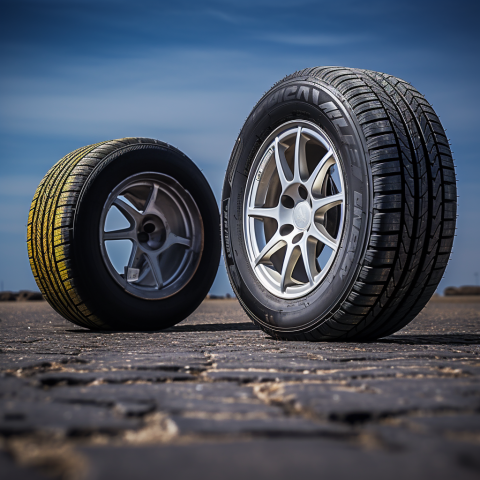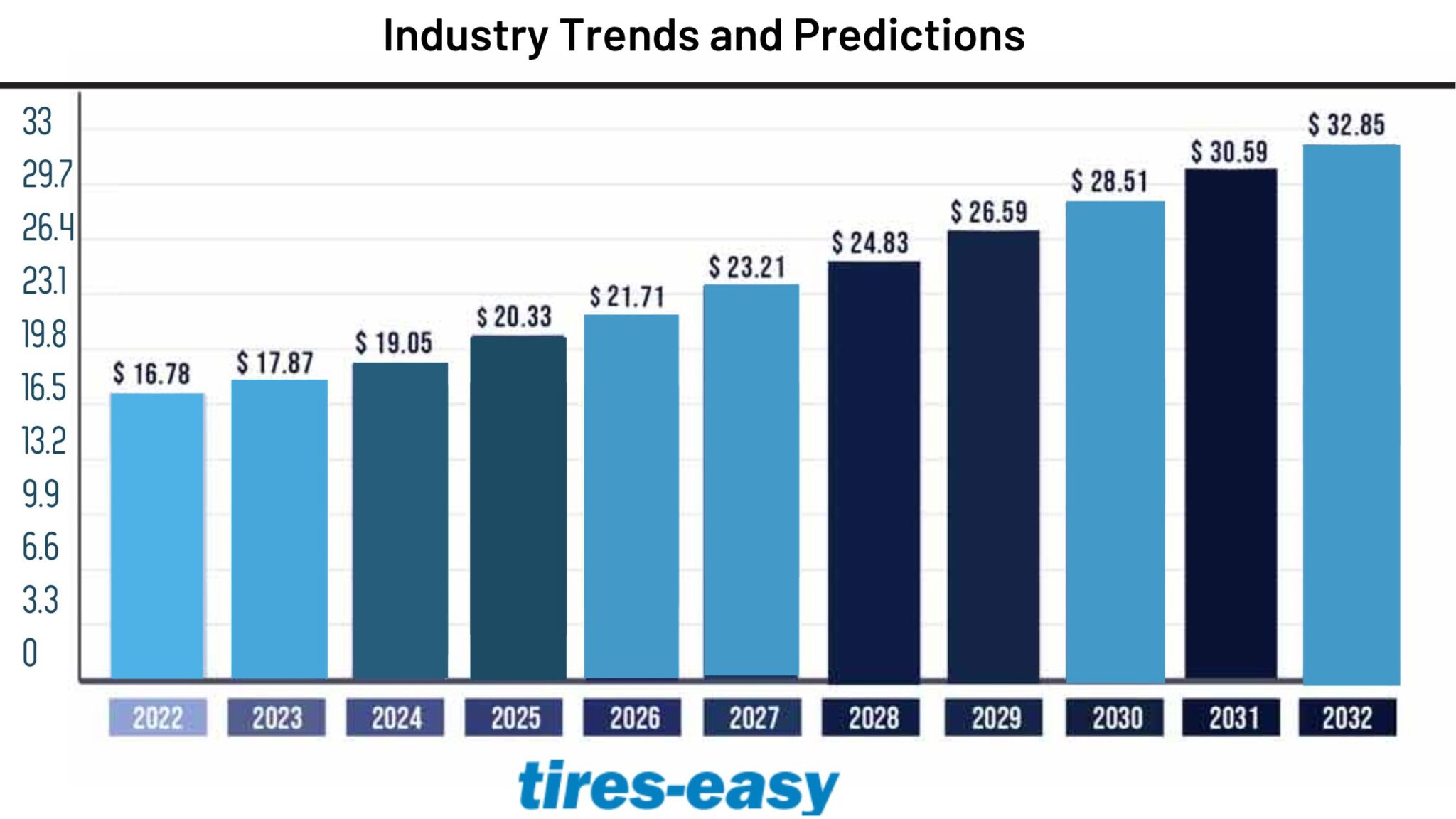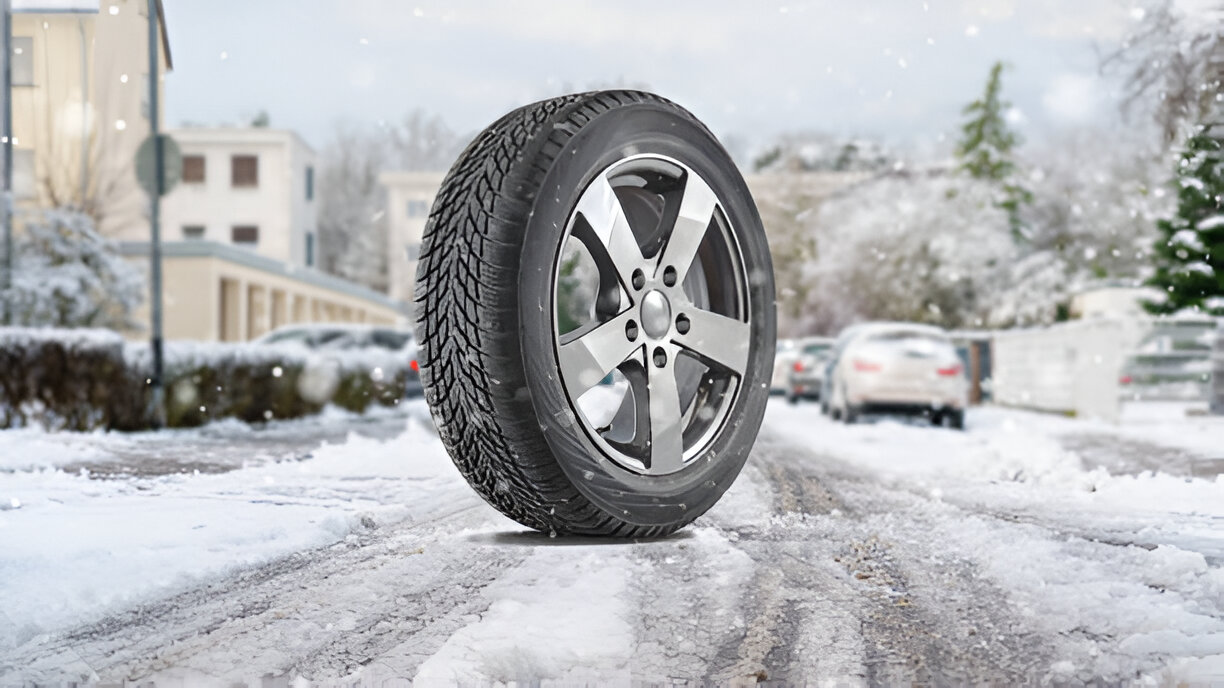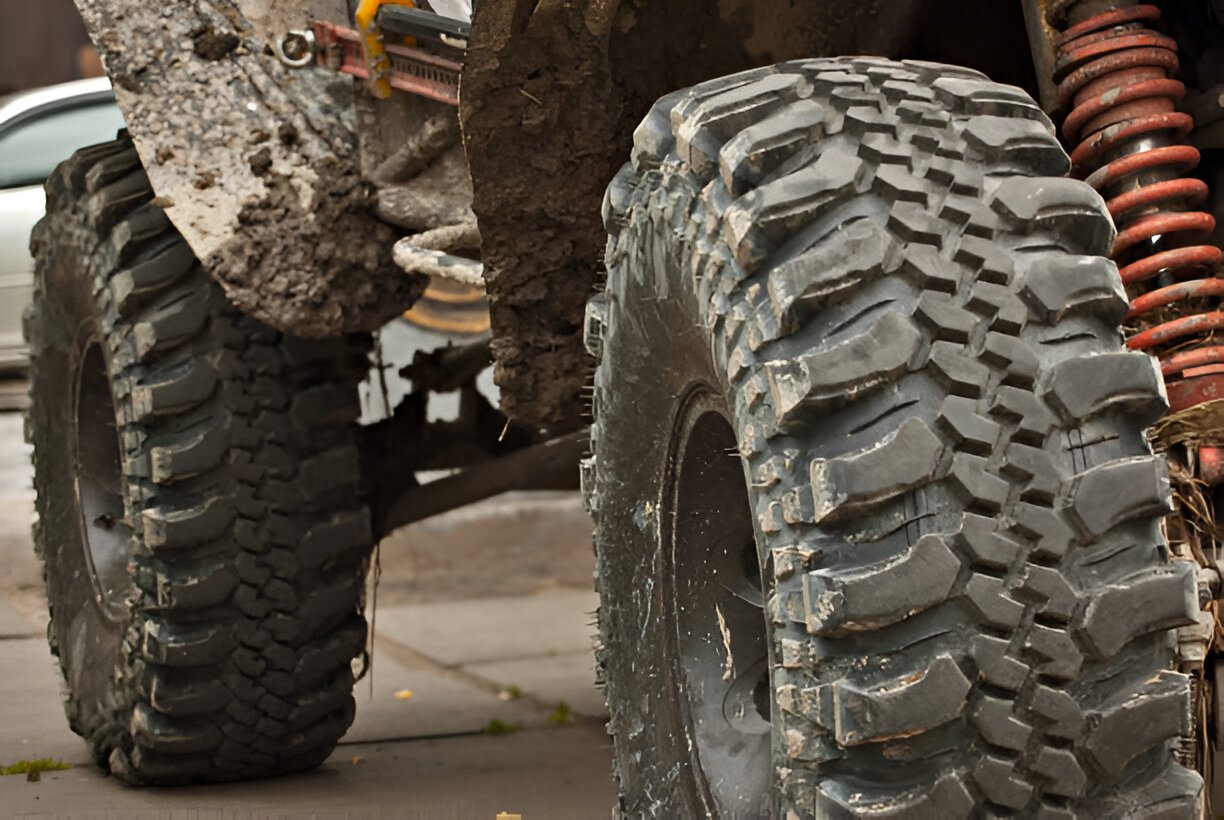Last Updated on July 25, 2025
Understanding Run-Flat Tires Design and Structure
Run-flat tires are a significant advancement in vehicle technology, providing a safer and more convenient option to regular tires in case of a rupture or blowout. Unlike conventional tires, run-flat tires are intended to maintain structural integrity and operate for a limited distance despite losing air pressure. This capability is primarily due to their strengthened sidewalls, which are strong enough to carry the vehicle’s weight without air.
Safety Benefits
The safety advantages of run-flat tires are notable. During a puncture, these tires allow drivers to maintain better control over their vehicle than a standard tire blowout. This capability is especially crucial at high speeds or in dangerous driving conditions. Moreover, run-flat tires eliminate the immediate need to change a tire on a busy road, enhancing passenger safety.
Performance and Comfortxz3
While run-flat tires are known for their safety features, they also have some impact on vehicle performance and comfort. The stiffer sidewalls result in a firmer ride, and the tires also contribute to slightly reduced fuel efficiency due to increased weight and rolling resistance. However, these factors are often considered a worthwhile trade-off for the added safety and convenience.
The Evolution of Run-Flat Technology
Run-flat tire technology has progressed over several decades, motivated by the need to improve car safety and convenience.
Early Developments
The concept of run-flat tires dates back to the early 20th century, but significant advancements were made in the 1980s and 1990s. During this period, major tire manufacturers began experimenting with designs that could withstand punctures and continue to operate without air pressure.
Technological Breakthroughs
The 2000s saw significant technological advances in run-flat technology. This era witnessed the advent of more advanced materials and designs, which enhanced tire performance, durability, and ride comfort. Introducing tire pressure monitoring systems (TPMS) in automobiles improved the functionality of run-flat tires by alerting drivers of pressure drops.
Adoption and Integration
Initially, run-flat tires were limited to high-end or sports cars. However, as technology advanced, their use spread to a broader range of vehicles, including family sedans and SUVs. This widespread use demonstrated the growing realization of the benefits of run-flat technology in improving vehicle safety and convenience.
Future Trends
The future of run-flat technology will likely focus on further improving comfort and performance while reducing the environmental impact. Material science and tire design advances could lead to lighter, more fuel-efficient run-flat tires that offer a ride quality closer to standard tires.
Understanding run-flat tires and appreciating their evolution is crucial for modern drivers. They are special tires that can keep rolling for a short distance even after a puncture, giving you time to pull over and get help safely. This can significantly benefit, especially on a busy highway or in bad weather.
Run-flat tires are becoming increasingly popular as technology improves. They offer drivers more peace of mind and convenience on the road. We can expect them to become even more common, making driving safer and more enjoyable for everyone.
Principles of Run-Flat Tire Operation
Run-flat tires are a marvel of 21st-century engineering, designed to prevent tire failure while driving. The basic idea of run-flat technology is to allow your vehicle to continue driving safely for a specified distance after the tire has lost all air pressure.
Key Structural Features
- Reinforced Sidewalls: The most distinctive feature of run-flat tires is their reinforced sidewalls. These robust, heat-resistant materials can help support the vehicle’s weight even when your tire is deflated.
- Thicker and Stiffer Construction: Run-flat tires typically have a broader and stiffer construction than standard tires. This design supports your vehicle without air pressure and helps maintain control and stability.
- Heat-Resistant Materials: Run-flat tires are made with unique compounds that can withstand the heat generated during a loss of air pressure. This resistance to heat helps prevent the tire from disintegrating while driving without air.
Types of Run-Flat Tires
- Self-Supporting: This is the most common type of stiffer and thicker sidewalls that can carry your car’s weight in case of air pressure loss.
- Auxiliary-Supported: This system uses a ring of hard material attached to the wheel, supporting the vehicle’s weight if the tire loses air.
How Run-Flat Tires Differ from Standard Tires
The differences between run-flat tires and standard tires are not just in the design but also in their overall functionality and impact on the driving experience.
Performance in Air Loss
- Ability to Continue Driving: The most notable distinction is that run flat tires can continue to work after a puncture for up to 50-100 miles at lower speeds (generally up to 50 mph), depending on the manufacturer’s standards.
- Safety in Case of a Blowout: Run flat tires offer your vehicle improved safety during a blowout, as they are less likely to lose shape and stability, reducing the risk of accidents.
Ride Quality and Handling
- Stiffer Ride: Run-flat tires typically ride more challenging than conventional tires due to their strengthened structure. Some drivers may experience a decrease in ride comfort.
- Handling and Stability: The thicker sidewalls of run-flat tires can improve the vehicle’s handling and stability, especially at higher speeds or during cornering.
Maintenance and Replacement
- Tire Pressure Monitoring Systems (TPMS): Vehicles with run-flat tires typically include TPMS, as detecting when a tire loses pressure is vital.
- Specialized Replacement Requirements: Run-flat tires often require technical replacement procedures and are typically more expensive than standard tires.
Environmental and Space Considerations
- Reduced Need for a Spare Tire: With run-flat tires, there will be no need to carry a spare tire, which can save space and reduce vehicle weight.
- Manufacturing and Disposal: The production of run-flat tires involves more material, and their disposal can be more challenging due to the robust materials used in their construction.
Run-flat tires represent a considerable advancement in car safety. Their particular shape and construction allow drivers to maintain control and mobility even after a tire puncture or blowout. While they provide significant safety and convenience benefits, they significantly alter the driving experience, maintenance requirements, and overall vehicle dynamics compared to standard tires. As technology progresses, the distinctions between run-flat and common tires may blur, resulting in increased comfort and performance.

Advantages of Run-Flat Tires
Run-flat tires, a significant development in automotive technology, offer unique benefits that enhance both safety and convenience for drivers. These tires are designed to remain functional and safe to drive on, even after losing all air pressure due to a puncture or a cut, contributing to their growing popularity among vehicle manufacturers and owners.
Safety Benefits
The primary advantage of run-flat tires lies in their contribution to vehicular safety. Run-flat tires offer enhanced safety by allowing drivers to continue driving at a reduced speed for a limited distance even after a puncture, reducing the risk of accidents from sudden tire blowouts and eliminating the need for immediate roadside tire changes.
Enhanced Control During a Blowout
- Maintained Vehicle Control: In the event of a puncture, run flat tires keep their shape better than standard tires. This stability helps control the vehicle better, reducing the risk of accidents.
- Prevention of Sudden Deflation: Traditional tires can rapidly deflate in case of a puncture, which can lead to loss of control. Run-flat tires, however, are designed to prevent sudden deflation, offering a safer driving experience.
Reducing the Risk of Accidents
- Improved Handling in Emergencies: The reinforced structure of run-flat tires allows for better vehicle handling during tire emergencies, making it easier to steer to safety.
- Decreased Likelihood of Tire-Related Accidents: The ability to continue driving on a punctured tire significantly reduces the risk of accidents caused by tire blowouts.
Convenience in Case of a Puncture
Apart from safety, run-flat tires offer considerable convenience, particularly during a puncture.
Eliminating the Need for Immediate Tire Change
- Driving to Safety or Service Center: With run-flat tires, you can continue pushing for a certain distance (typically 50-100 miles) after a puncture, which allows you to reach a service center or a safe location for tire replacement.
- No Need for Roadside Tire Changes: This capability eliminates the need for an immediate and potentially risky roadside tire change, particularly in adverse weather conditions or unsafe locations.
Space and Weight Saving
- No Spare Tire Required: Vehicles equipped with run-flat tires do not require a spare tire, which frees up trunk space and reduces overall vehicle weight, potentially improving fuel efficiency.
- Simplified Vehicle Design: The absence of a spare tire can also lead to a more streamlined vehicle design, allowing manufacturers more freedom in designing the interior and storage spaces.
Reduced Downtime and Enhanced Mobility
- Less Disruption During Travel: Experiencing a flat tire no longer means an immediate stop and delay. You can continue your journey and plan the tire repair or replacement.
- Greater Peace of Mind: Knowing you can drive a considerable distance even after a tire gets punctured provides security and peace of mind, especially during long trips or remote areas.
Regular tires can leave you stranded with a flat, but run-flat tires are like having a backup plan built right in. They can keep you rolling even after,r a puncture, so you don’t have to worry about changing a tire on the side of the road. This is a significant safety plus, especially on a busy highway or in bad weather.
Run-flat tires are getting more popular as they get better and better. They give drivers more peace of mind and make driving much more convenient. As cars get fancier, we can expect to see run flat tires become even more common, making the roads safer and smoother for everyone.
Limitations and Considerations
While run-flat tires provide significant safety and convenience benefits, they have several restrictions and considerations that users should be aware of. Understanding these characteristics is necessary to make sound decisions concerning run-flat tires and ensure their proper use.
Distance Limitations
One of the primary limitations of run-flat tires is the restricted distance they can cover after sustaining a puncture.
Limited Range After a Puncture
- Specific Distance Capacity: Once your tire gets punctured, run-flat tires can typically sustain a vehicle for about 50 to 100 miles, although this range can vary based on the tire brand, model, and the vehicle’s load.
- Manufacturer’s Recommendations: To minimize further damage to the tire or the vehicle, you must follow the manufacturer’s guidelines for the maximum distance these tires may cover after losing air pressure.
Impact on Travel Plans
- Need for Timely Repair or Replacement: You must plan for a prompt tire repair or replacement within the specified distance range to ensure safety and maintain the tire’s integrity.
- Considerations for Long Trips: You should consider the limited range of run-flat tires post-puncture for long-distance travel, as it may affect travel plans or require adjustments in remote areas.
Speed Restrictions
Run-flat tires also have certain speed limitations when they are in a deflated condition.
Reduced Speed Post-Puncture
- Reduced Maximum Speed: Usually, after a puncture, your run-flat tires should not be driven faster than 50 mph. This constraint is required to prevent further tire damage and control the vehicle.
- Handling and Control at Reduced Speeds: Run-flat tires operate differently at lower speeds, particularly in handling and control than at higher speeds, necessitating caution when driving.
Importance of Adhering to Speed Guidelines
- Safety Concerns: Exceeding the recommended speed on a deflated run-flat tire can lead to safety risks, including loss of control or additional damage to the tire and the vehicle.
- Warranty Considerations: Not adhering to the prescribed speed limits can also affect warranty claims on the tires.
Impact on Fuel Efficiency
The design and construction of run-flat tires can influence a vehicle’s fuel efficiency. Here are some of the effects it has on your fuel efficiency.
Increased Rolling Resistance
- Heavier Construction: Run-flat tires are generally heavier due to their reinforced structure, which can increase rolling resistance.
- Effect on Fuel Consumption: This increased rolling resistance can slightly decrease fuel efficiency, as the vehicle requires more energy to maintain speed.
Balancing Safety and Efficiency
- Comparative Analysis: While the impact on fuel efficiency is generally minor, you need to weigh the safety benefits of run-flat tires against their effect on fuel consumption.
- Vehicle Design Considerations: Automakers often include the characteristics of run-flat tires in vehicle design, which can help reduce some of the effects on fuel efficiency.
Despite all these benefits, run-flat tires have certain limitations and considerations, which include distance limitations post-puncture and speed restrictions for safety. It is crucial for users to be aware of these factors and to follow manufacturer guidelines to ensure optimal performance and safety. While these limitations may affect certain aspects of driving, they are often considered an acceptable trade-off for the enhanced safety and convenience that run-flat tires provide.
Brand-Specific Run-Flat Tire Guidelines
Run-flat tires have become increasingly popular, and several leading tire manufacturers have developed their versions with specific guidelines and technologies. Understanding the unique aspects of run-flat tires offered by brands like Michelin, Bridgestone, and Continental is essential for proper usage and maintenance.
Michelin
Michelin is renowned for its high-quality tires, and its run-flat offerings are no exception.

Michelin’s Run-Flat Technology
- PAX System: One of Michelin’s notable run-flat innovations is the PAX system, which allows your vehicle to drive up to 125 miles at 55 mph even after a puncture. This system uses a support ring attached to the wheel, enabling continued performance after air loss.
- Self-Supporting Tires: Michelin also offers self-supporting run-flat tires designed with reinforced sidewalls.
Usage and Maintenance Guidelines
- Regular Inspections: Michelin advises that you do regular tire inspections to check for wear and damage, especially since run-flats may not visibly sag when they lose pressure.
- Tire Pressure Monitoring System (TPMS): Michelin run-flat tires should be used with a TPMS, as it’s crucial for detecting loss of air pressure.
Bridgestone
Bridgestone is another major player in the run-flat tire market, known for its innovative approach and quality.
Bridgestone’s Run-Flat Technology
- Reinforced Sidewall Technology: Bridgestone run-flat tires use a robust sidewall technology to maintain shape and support the vehicle’s weight after a puncture.
- DriveGuard Tires: Bridgestone’s DriveGuard tires are designed to provide a comfortable ride and extended mobility for up to 50 miles at up to 50 mph after a puncture.
Guidelines for Use
- Speed and Distance Limitations: Bridgestone emphasizes adherence to speed and distance limitations after a puncture to ensure safety.
- Compatibility: Ensure that Bridgestone run-flat tires are compatible with your vehicle, especially regarding load and speed ratings.
Continental
Continental has developed its line of run-flat tires, focusing on safety and performance.
Continental’s Run-Flat Technology
- SSR System: Continental’s Self Supporting Runflat (SSR) system is essential to its run-flat tire design, offering extended mobility and safety.
- Reinforced Sidewalls: Like other brands, Continental run-flats feature reinforced sidewalls that can bear the car’s weight even without air pressure.
Operating Recommendations
- TPMS Requirement: Continental strongly advises that their run-flat tires be used on vehicles equipped with a TPMS.
- Regular Maintenance: Regular checks for tire damage and wear are crucial, and Continental recommends replacing run-flat tires more frequently than standard tires.
Each tire manufacturer’s approach to run-flat technology includes specific standards and features. Michelin’s PAX system and self-supporting tires, Bridgestone’s DriveGuard technology, and Continental’s SSR system all provide unique benefits but must be used and maintained according to particular criteria. Understanding these brand-specific properties is critical for run-flat tires’ maximum performance and safety. Regular maintenance inspections, adhering to speed and distance limits after puncture, and using TPMS are all universal suggestions across various brands, preserving the longevity and efficiency of run-flat tires.
Driving on Run-Flat Tires
Run-flat tires are designed to provide safety and convenience, but it is essential to understand how to use them correctly. This includes knowing how to identify a puncture, the proper driving techniques after a puncture, and how to care for the tire post-puncture.
Identifying a Puncture
Run-flat tires are built to maintain their structure and support the vehicle even when they lose air. However, identifying a puncture in a run-flat tire can be different than with standard tires.
Signs of a Punctured Run-Flat Tire
- Tire Pressure Monitoring System (TPMS) Alert: Most modern vehicles with run-flat tires also have a TPMS that alerts the driver when tire pressure drops significantly.
- Change in Driving Dynamics: While run-flats maintain performance to an extent, a loss of air pressure can still alter the handling or noise levels of the vehicle. Drivers might notice a difference in steering response or increased road noise.
Driving Techniques and Precautions
After a puncture, how you drive can affect your safety and the tire’s condition.
Adjusted Driving Habits
- Reduced Speed: It is crucial to reduce speed immediately after detecting a puncture. Generally, it’s advised not to exceed 50 mph on a punctured run-flat tire.
- Avoid Sudden Maneuvers: Sharp turns or sudden brakes can be more dangerous on a punctured run-flat tire and should be avoided.
Planning Your Route
- Head to the Nearest Service Center: Plan to visit a service center within the specified range (usually 50-100 miles) that the run-flat tires can safely cover after a puncture.
- Avoid Rough Roads: Stick to smooth roads if possible because rough terrain can increase the damage to a punctured tire.
Post-Puncture Care
Taking care of a run-flat tire after a puncture is essential to maintain its integrity and your vehicle’s safety.
Inspection and Repair
- Professional Inspection: Always have the tire inspected by a professional. Some run-flat tires can be repaired, but others may need replacement, depending on the extent of the damage and the manufacturer’s guidelines.
- Replacement Guidelines: In many cases, run-flat tires must be replaced after a puncture. It’s essential to follow the manufacturer’s recommendations regarding repair and replacement.
Monitoring and Maintenance
- Regular Checks: Regularly check all tires, including run-flats, for signs of wear and tear, even if they haven’t been punctured.
- Keeping a Check on Tire Pressure: Maintaining the correct tire pressure is crucial for the performance and longevity of run-flat tires.
Driving on run-flat tires offers a layer of safety and convenience, but it also requires awareness and specific driving practices. Identifying a puncture early through TPMS and changes in driving dynamics, adjusting driving techniques to ensure safety, and following proper post-puncture care are essential steps in managing run-flat tires effectively. Regular maintenance and adhering to manufacturer guidelines will ensure these tires serve you well, providing peace of mind and safety on the road.
Maintenance and Care of Run-Flat Tires
Run-flat tires provide a significant benefit in terms of safety and convenience, but like all tires, they require regular maintenance and care to perform correctly. Regular check-ups, adherence to replacement methods, and tire pressure monitoring are essential to maintaining these specialist tires.
Regular Check-Ups
Regular maintenance check-ups are crucial for ensuring the longevity and performance of run-flat tires.
Visual Inspections
- Tread Wear: Regularly check the tires’ tread for uneven or excessive wear patterns. Run-flat tires may wear differently than standard tires due to their stiffer sidewalls.
- Sidewall Checks: Inspect the sidewalls for cuts, bulges, or other signs of damage. The reinforced sidewalls are critical for the tire’s run-flat capabilities so any damage can be a significant concern.
Professional Inspections
- Routine Servicing: Having your tires checked by a professional during regular servicing is a good practice. They can spot issues that might take time to be noticeable.
- Post-Puncture Examination: After a run-flat tire has been driven on while flat, it’s essential to have it examined by a professional to assess whether it can be repaired or needs to be replaced.
Replacement Protocols
Run-flat tires often have specific protocols for replacement that differ from standard tires.
When to Replace
- Manufacturer’s Guidelines: Always follow the tire manufacturer’s guidelines regarding replacement intervals. Some run-flat tires may need to be replaced more frequently than standard tires.
- After a Puncture: If a tire has been driven on while flat, replacing it is often recommended rather than repairing it. This depends on the extent of the damage and the manufacturer’s advice.
Replacement Procedures
- Matching Tires: Ensure that the new run-flat tire matches the others on the vehicle in terms of size, type, and brand. Mismatched tires can affect the vehicle’s handling and safety.
- Professional Installation: Due to their unique structure, run-flat tires should be installed by professionals familiar with the correct procedures for these types of tires.
Tire Pressure Monitoring
Tire pressure monitoring is a crucial aspect of maintaining run-flat tires. Tire pressure monitoring systems (TPMS) are essential for maintaining optimal tire pressure and providing real-time alerts to drivers about under-inflation. This can prevent uneven tire wear, reduce the risk of blowouts, and improve overall vehicle efficiency and safety.
Importance of TPMS
- Early Detection: A Tire Pressure Monitoring System (TPMS) is essential for early detection of loss of air pressure in run-flat tires. Since run-flats do not visibly sag when they lose pressure, a TPMS is often the only way to know that a tire has been punctured.
- Regular Checks: You should check the TPMS to ensure it functions correctly. If the system indicates a tire pressure issue, address it immediately.
Maintaining Correct Pressure
- Regular Pressure Checks: Even with a TPMS, manually check your tire pressure regularly to ensure they are at the recommended levels. Proper inflation is crucial for the performance and longevity of run-flat tires.
- Adjustments for Load and Conditions: Adjust tire pressure as necessary for different loads and driving conditions, as the manufacturer recommends.
The maintenance and care of run-flat tires are critical for ensuring their performance and longevity. Regular visual and professional check-ups are necessary for identifying potential issues. Adhering to specific replacement protocols is crucial, especially considering the unique characteristics of these tires. Additionally, tire pressure monitoring is vital in maintaining the optimal condition of run-flat tires. Proper maintenance extends the life of these tires and ensures safety and reliability on the road.
Case Studies and Real-World Experiences
Run-flat tires represent a significant advancement in automotive safety and convenience. However, like any technology, they have been tested and refined through real-world experiences and case studies. These narratives not only highlight the benefits but also reveal the challenges faced by users, offering insights into the practical aspects of run-flat tire usage.
Emergency Situations
- Avoiding Roadside Hazards: There are numerous accounts from drivers who have benefited from the safety features of run-flat tires during emergencies. One notable example is a driver who experienced a tire puncture on a busy highway. Thanks to the run-flat tires, they could maintain vehicle control and safely navigate to the nearest service station, avoiding a potentially dangerous roadside tire change.
- Long-Distance Travel: Travelers have reported instances where run-flat tires have enabled them to continue their journeys despite tire damage, which is particularly beneficial in remote areas where immediate assistance is unavailable.
Daily Commutes
- Urban Driving Convenience: In urban settings, drivers have praised the convenience of run-flat tires. For instance, a commuter in a significant city experienced a puncture during rush hour traffic. The run-flat tires allowed them to continue their commute and address the tire issue later without disrupting an immediate tire change.
Challenges and Resolutions
While the success stories are compelling, there have also been challenges in adopting and using run-flat tires.
Handling and Comfort Concerns
- Ride Quality: Some drivers have noted a stiffer ride quality due to the reinforced sidewalls of run-flat tires. However, tire manufacturers have continually improved the construction to enhance comfort without compromising safety.
- Adjustment Period: New users of run-flat tires often report an adjustment period, particularly in handling and responsiveness. Driver education and awareness about the characteristics of run-flat tires have been vital in addressing these concerns.
Maintenance and Replacement Issues
- Cost of Replacement: Run-flat tires can be more expensive to replace than standard tires, which has been a point of contention for some users. To address this, some manufacturers have introduced more cost-effective models and have worked to extend the overall lifespan of these tires.
- Limited Repair Options: Initially, there were concerns about the repairability of run-flat tires and the availability of suitable replacements. Increased availability and advancements in tire repair techniques have mitigated mainly this issue.
Adaptation by Vehicle Manufacturers
- Integration in New Models: Many new vehicle models now come equipped with run-flat tires as standard, reflecting their growing acceptance and the resolution of early teething problems. This integration has been facilitated by continuous feedback from real-world users and subsequent improvements by tire manufacturers.
The real-world experiences and case studies of run-flat tires comprehensively show their evolution and practicality. Success stories underscore their value in enhancing safety and convenience, particularly in emergencies. Early adopters’ challenges have led to significant technological improvements, addressing comfort, maintenance, and cost issues. These developments highlight the dynamic nature of automotive technology and the importance of user feedback in driving innovation and improvement.
Future of Run-Flat Tires
The future of run-flat tires is a subject of considerable interest within the automotive industry. With ongoing technological advances and evolving industry trends, the scope and application of run-flat tires are expected to expand and improve. Predictions about their future involve technological innovation, changes in consumer preferences, and automotive standards.
Technological Advances
The continuous evolution of run-flat tire technology is characterized by efforts to enhance their performance, safety, and user-friendliness.
Material Innovations
- New Compounds: Material science research focuses on developing new rubber compounds and reinforcement materials to make run-flat tires lighter, more durable, and more fuel-efficient.
- Improved Ride Comfort: Tire design advances aim to reduce the stiffness of run-flat tires to improve ride comfort, bringing them closer to conventional tires.
Enhanced Safety Features
- Increased Puncture Resistance: Future run-flat tires may incorporate materials or designs that increase their resistance to punctures and cuts, further enhancing their safety profile.
- Integrated Sensors: There is an ongoing development in sensor technology to provide real-time tire health monitoring, including advanced warning systems for tire pressure loss, tread wear, or structural damage.
Industry Trends and Predictions
The recent trends in the automotive industry indicate a bright future for run-flat tires because of the increased consumer demand and industry regulations.
Growing Market Adoption
- Standard in New Models: Run-flat tires are predicted to become standard equipment in more vehicle models, particularly in luxury and high-performance segments. This trend is likely to trickle down to the broader market over time.
- Aftermarket Growth: As consumer awareness increases, the demand for aftermarket run-flat tires is expected to grow, catering to drivers who wish to upgrade their existing vehicles for enhanced safety.
Focus on Sustainability
- Eco-friendly Production: The tire industry, including the run-flat sector, is moving towards more sustainable production practices. This includes using environmentally friendly materials and processes that reduce the carbon footprint.
- Recycling and Reusability: Future advancements may focus on making run-flat tires more recyclable, addressing the current challenges of disposing of these robust tires.
Impact of Autonomous and Electric Vehicles
- Adaptation to EVs: Electric vehicles (EVs) present unique tire requirements, such as low rolling resistance for increased range. Run-flat tires are expected to evolve to meet these specific needs.
- Compatibility with Autonomous Technology: As autonomous vehicles become more prevalent, run-flat tires will likely be designed to complement this technology, offering reliability and safety that align with autonomous driving systems.
Exciting technology developments and critical industry trends will shape the future of run-flat tires. Materials and design innovations are expected to boost performance and comfort levels. At the same time, industry trends point to further acceptance and integration of future automotive technologies such as electric and self-driving vehicles. As environmental concerns influence manufacturing techniques, run-flat tires will become more sustainable. These improvements point to a bright future for run-flat tires, firmly establishing them as essential to automobile safety and performance.
Conclusion & Recommendations
Run-flat tires have become an essential part of modern vehicular safety and convenience. Their ability to withstand punctures and continue functioning has redefined expectations for tire performance. Key takeaways from our exploration of run-flat tires include:
- Enhanced Safety: Run-flat tires significantly reduce the risk of accidents due to blowouts and allow drivers to maintain control in case of a puncture.
- Continued Mobility: These tires enable drivers to continue their journey for a certain distance, even with a complete loss of air pressure.
- Regular Maintenance: Despite their robustness, regular check-ups and adherence to replacement processes are essential for ensuring their effectiveness.
- Technological Developments: The future of run-flat tires is bright, with ongoing advancements to improve comfort, efficiency, and environmental sustainability.
Final Recommendations
With all the benefits and considerations associated with run-flat tires, here are some final recommendations:
- For New Car Buyers: Consider vehicles equipped with run-flat tires, especially if safety and convenience are top priorities.
- For Current Vehicle Owners: If your current vehicle does not have run-flat tires, consider a replacement option, particularly if you value safety and convenience during travel.
- Maintenance is Key: Regular maintenance and inspections are crucial. Even though run-flat tires are durable, they still require attention to ensure they perform as intended.
- Stay Informed: Keep up with the latest developments in tire technology to make informed decisions about tire purchases and care.
Why Tires Easy
In light of these insights and recommendations, ensuring you have the best tires for your vehicle is crucial. For those looking to purchase run-flat tires or seeking more information, Tires Easy offers a comprehensive selection to suit various needs and preferences.
- Wide Selection: Find various run-flat tires from top brands, each designed to offer safety, reliability, and peace of mind.
- Expert Advice: Benefit from expert insights and guidance to choose the best run-flat tires for your vehicle and driving needs.
- Competitive Pricing: Get the best value for your investment with competitive pricing on high-quality run-flat tires.
Whether upgrading to run-flat tires for the first time or looking for a replacement, Tires Easy is your go-to destination for all your tire needs. Explore their range, consult with their experts, and make a choice that aligns with both your safety and comfort needs.
Find Your Perfect Run-Flat Tires Today.
Visit Tires Easy and embark on a journey of improved safety, durability, and peace of mind with your vehicle’s correct set of tires.
FAQs
What is a run-flat tire?
A run-flat tire is designed to withstand deflation when punctured, allowing you to drive slower for a limited period, usually 50-100 miles, even after losing air pressure.
What is the disadvantage of a run-flat tire?
Some disadvantages of run-flat tires are their higher cost, stiffer ride due to reinforced sidewalls, limited repair options, and often more challenging to replace than standard tires.
Are run-flat tires better than regular tires?
Run-flat tires improve safety by providing stability following a puncture and eliminating the emergency roadside tire change requirement. However, they are more expensive and give a more challenging ride than standard tires.
Are running flat tires a good thing?
Run-flat tires are beneficial because they ensure safety and convenience, allowing continued driving after a puncture. This function is handy for avoiding dangerous roadside tire changes.
How long can you go with a run-flat tire?
You can typically drive on a run-flat tire for about 50 to 100 miles after a puncture, but this can vary depending on the tire’s make, the vehicle’s load, and driving conditions.
Can I drive 100 miles on a run-flat?
It is possible to drive 100 miles on a run-flat tire. Nonetheless, following the manufacturer’s standards, which typically indicate a distance of 50 to 100 miles at a reduced speed after a puncture, is essential.
How far can you drive on a BMW run-flat tire?
On a BMW run-flat tire, you can usually go up to 100 miles after losing air pressure, but it’s essential to adhere to a reduced speed limit, typically around 50 mph, to ensure safety.
How many km is a run-flat tire?
A run-flat tire usually covers about 80 to 160 kilometers (50 to 100 miles) after a puncture, depending on the tire’s specifications and driving conditions.
-
Automotive Specialist
-
Proofreader
-
Writer











